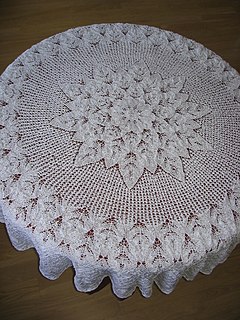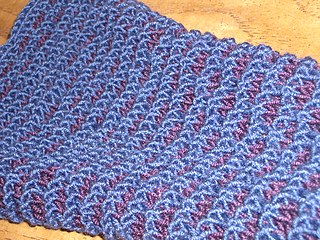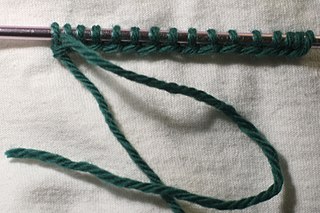
Crochet is a process of creating fabric by interlocking loops of yarn, thread, or strands of other materials using a crochet hook. The name is derived from the French term crochet, meaning 'small hook'. These are made of materials such as metal, wood, or plastic and are manufactured commercially and produced in artisan workshops. The salient difference between crochet and knitting, beyond the implements used for their production, is that each stitch in crochet is completed before the next one is begun, while knitting keeps a large number of stitches open at a time.
Intarsia is a knitting technique used to create patterns with multiple colours. As with the woodworking technique of the same name, fields of different colours and materials appear to be inlaid in one another, fit together like a jigsaw puzzle.

Lace knitting is a style of knitting characterized by stable "holes" in the fabric arranged with consideration of aesthetic value. Lace is sometimes considered the pinnacle of knitting, because of its complexity and because woven fabrics cannot easily be made to have holes. Famous examples include the wedding ring shawl of Shetland knitting, a shawl so fine that it could be drawn through a wedding ring. Shetland knitted lace became extremely popular in Victorian England when Queen Victoria became a Shetland lace enthusiast. Her enthusiasm resulted i.a. in her choosing knitted lacework for presents; e.g. when in ca. 1897 the Queen gave a lace shawl as a present to American abolitionist Harriet Tubman. From there, knitting patterns for the shawls were printed in English women's magazines where they were copied in Iceland with single ply wool.

Slip-stitch knitting is a family of knitting techniques that use slip stitches to make multiple fabrics simultaneously, to make extra-long stitches, and/or to carry over colors from an earlier row.

Drop-stitch knitting is a knitting technique for producing open, vertical stripes in a garment. The basic idea is to knit a solid fabric, then (deliberately) drop one or more stitches, producing a run in the fabric. The run will continue to the bottom edge of the garment, or until it encounters an increase, at which it stops.

In knitting, casting on is a family of techniques for adding new stitches that do not depend on earlier stitches, i.e., stitches having an independent lower edge. In principle, casting on is the opposite of binding off, but the techniques involved are generally unrelated.
Knitting abbreviations are often used for brevity in describing knitting patterns.

In knitting, welting is the horizontal analog of ribbing; that is, one or more horizontal rows of knit stitches alternating with one or more rows of purl stitches.

In knitting, a gather is a generic term for the several methods that draw stitches closer together laterally, i.e., within a row of knitting. Common methods include:
In knitting, weaving is a family of techniques used for several purposes in knitting.

In knitting, a short row is a row that is not fully knitted; the work is turned before reaching the end of the row. Just before the work is turned, the yarn is generally passed around the next unknitted stitch to prevent a hole from forming at the turning point.

Double knitting is a form of hand knitting in which two fabrics are knitted simultaneously on one pair of needles. The fabrics may be inseparable, as in interlock knitted fabrics, or they can simply be two unconnected fabrics. In principle, an arbitrary number of fabrics can be knitted simultaneously on one pair of knitting needles with yarns, as long as one is careful.
Knitted fabric is a textile that results from knitting. Its properties are distinct from woven fabric in that it is more flexible and can be more readily constructed into smaller pieces, making it ideal for socks and hats.

Illusion knitting or shadow knitting is a form of textile art, in which the knitting is viewed as simply narrow stripes from one angle, and as an image when viewed from another angle. Illusion knitting has been recognised as an art form since 2010, largely due to the advances made by Steve Plummer who has created several large and detailed pieces. Similar effects occur in Tunisian crochet.
A knitting pattern is a set of written instructions on how to construct items using knitting.













